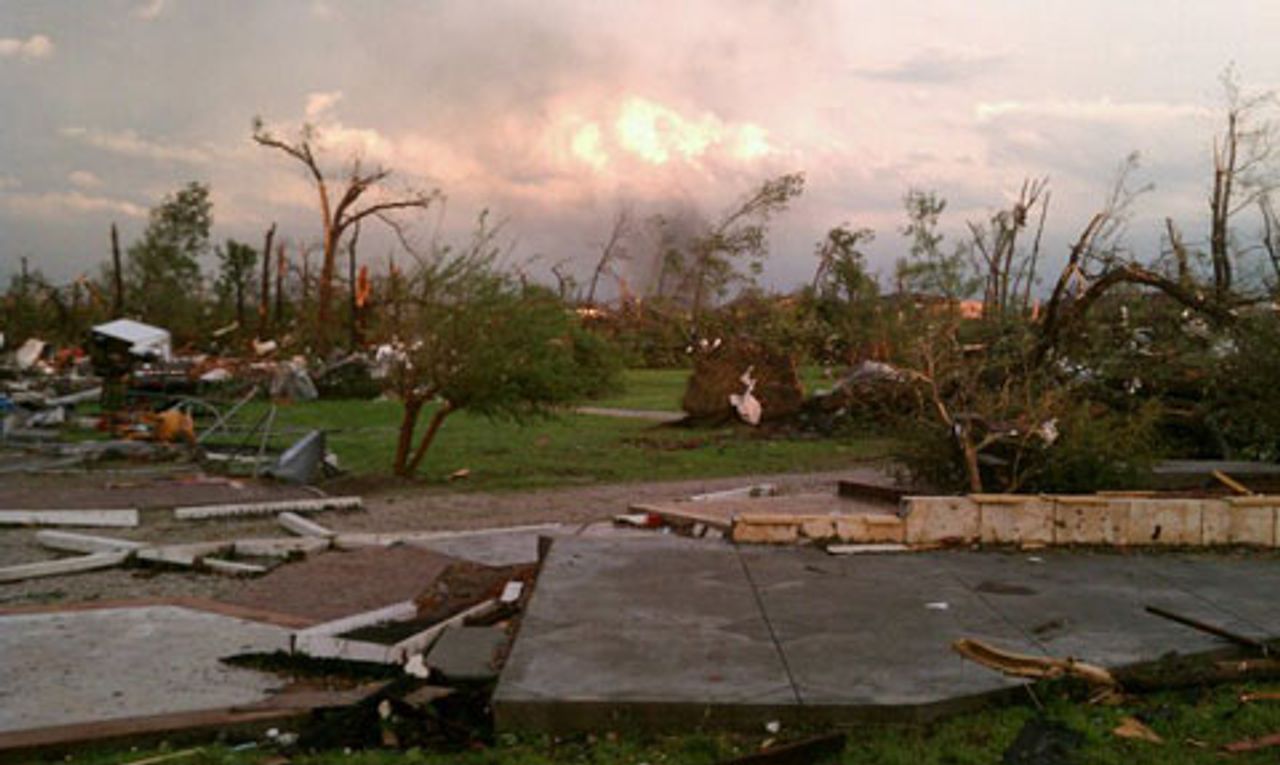The huge tornado that razed much of Joplin, Missouri Sunday evening, killing at least 116, was the deadliest in the US since 1953. Many remain missing and hundreds have been critically injured.
The storm cut a six-mile-long and nearly one-mile-wide swath through the downtown, striking a hospital, department stores, nursing homes, houses, schools, and entire apartment complexes.
 Destruction in Joplin [Photo by storm chaser Brandon Sullivan]
Destruction in Joplin [Photo by storm chaser Brandon Sullivan]The tornado “cut the city in half,” Joplin Fire Chief Mitch Randles said, estimating that 25 to 30 percent of the town was damaged. Most of the 50,000 residents are directly impacted by the destruction, and hundreds of thousands more in the greater metropolitan area will face power outages, lost work, and other economic hardship.
The Joplin tornado was one of 68 other cells moving through the Midwest over the weekend, including one that hit Minneapolis, Minnesota Sunday night. One person was killed by that storm; on Friday night a tornado claimed the life of a Kansas resident. More severe tornadoes are forecast for the region Tuesday.
The storm brings the year’s tornado death toll to at least 481, the most since 1953. The Joplin storm itself is the deadliest tornado since 1953, when a tornado hit Flint, Michigan, killing 116. Last month, 340 people were killed in a string of storms across the Deep South and Midwest.
The Joplin disaster once again lays bare certain social realities of American life. Masses of people live in cheaply fabricated housing, in towns with no public storm shelters and little forewarning of disaster. Thousands of the poorest people are exposed to both the raw force of nature and a protracted humanitarian disaster. Many lose what little they own and face the prospect of beginning anew without savings, insurance, or governmental help. (See: “The social conditions behind the deadly US tornado outbreak”)
Joplin residents were given less than 20 minutes’ warning as the storm bore down on the town, and may not have heard the warning sirens through the high winds and rain. The National Weather Service in Springfield identified the funnel cloud west of the city shortly after 5 p.m. Joplin’s sirens sounded at 5:11, just moments before the storm hit. Video captured by a storm-chaser as it entered the city show a funnel filling almost the entire breadth of the skyline.
Meteorologists estimate the tornado had wind speeds of up to 198 mph, placing it at the high end of an EF4, the second-highest ranking for tornado strength.
Images of the aftermath reveal destruction of an almost incomprehensible scale. In this aerial view of the town taken by television station KMBC, block after block of neighborhoods are shown reduced to unrecognizable tangles of debris.
On-the-spot reports by local news outlets portray chaos and desperation. Local authorities struggled to establish temporary morgues, triage centers, and house-by-house rescue crews Sunday night. Residents were pulling away rubble to try to extricate trapped neighbors and loved ones. Fires and natural gas leaks hampered the efforts.
St. John’s Regional Medical Center sustained a direct hit. The Joplin Globe reported at the scene: “An elderly man and woman were making their way from the wreckage of the hospital. Wrecked cars were piled on top of each other, windows were blown out, and streets were blocked by debris and by survivors trying to flee.” More than 100 patients had to be evacuated after the storm struck.
“The houses are all gone. The medical buildings are gone,” one resident told the newspaper. “[St. John’s hospital’s] windows have all been blown out. It was horrible. I couldn’t even take pictures on my phone. I was crying.” This video, shot from the parking lot of the hospital by first responders searching for victims, shows mangled vehicles and gutted buildings. Medical supplies, x-rays, and documents were flung as far as 70 miles from the hospital.
More than 1,000 people were injured. The Freeman Health System hospital, overwhelmed by the disaster, is admitting only critically injured patients. As of Monday afternoon, some 500 people had been treated, nine of whom died. The wounded were being transported to the hospital in the backs of pickup trucks and carried on splintered doors and plywood boards. A second emergency medical center set up was also quickly overwhelmed by the injured.
On Sunday night, the coroners of Newton and Jasper counties sent teams with body bags to the many restaurants and businesses in the hardest hit area. Newton County Coroner Mark Bridges told the Joplin Globe Sunday night that bodies were being pulled from places where victims had sought shelter but were crushed by roof collapses.
The roof of a Wal-Mart Supercenter caved in on many customers “It was a normal Sunday,” a store employee said. “There were probably about 150 people in the store. I don’t know how many got out.” The roof of a nearby Home Depot store also collapsed. Employees said they had only three minutes after hearing the sirens before the roof gave way.
Three public schools were completely destroyed and two others heavily damaged. School has been cancelled for the remainder of the academic year. “You see pictures of World War II, the devastation and all that with the bombing,” the principal of a destroyed high school told the Associated Press. “That’s really what it looked like.”
Over 100 people spent Sunday night in a shelter, a figure that is expected to rise in the coming days. Without electricity and safe water, a city spokesperson said, food and water shortages may compound the crisis.
